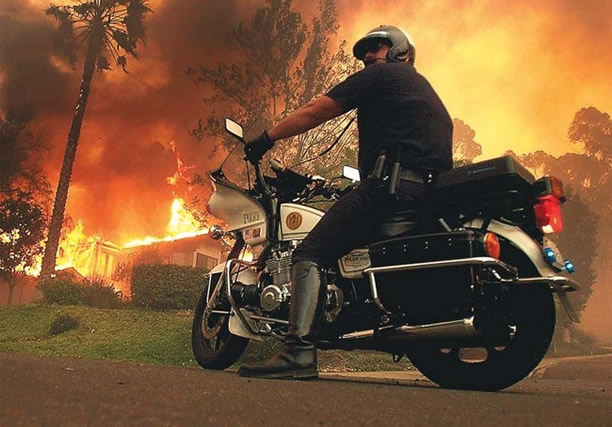San Diego is on fire, there are eight wild fires that have been burning with zero percent containment for more than twelve hours. I am writing this on my laptop with a Bluetooth connection to the internet from a downtown evacuation site. This was a mandatory evacuation that covered our office and my house.
|
There are dozens of people around me who packed their cars earlier this morning with their most prized personal items, documents, family and pets. It seems that most people have been able to get out. I am very thankful that the City of San Diego responded as quickly as it did. |

|
While I am sitting here, I am getting calls from clients who are panicked about their servers, data and corporate information. Most of them are out of the direct path of the fires but the concern is universal when it comes to disaster planning.
The disaster recovery plan for our office kicked into effect at about 6:30 this morning. We went through this about three years ago so we were up to date and current on our plan. Our employees knew what to do. But don’t assume that everyone in your office knows what to do in a disaster. For our office we had a conference call at 7 a.m, and we contacted each employee by 7:30 to confirm their status. Our critical business records are in secure fireproof storage and our servers are backed up remotely, so we are 100% covered off site for any system disasters.
We use BackupRight.com Our servers are backed up each night and we could be up in about four hours even if the office burned to the ground.
All of our employees are working from home, and the phones are being answered. We contacted our remote support group in the Philippines to notify them of the situation and emails have been sent out to our key vendors to notify them of the issue. We have also posted a statement on our website and are fully up and running remotely. We do have some network impact from the fires but 99% of our installed infrastructure and clients are up and running.
Here is a quick guide for Business Disaster Planning:
Am I prepared to relocate temporarily? What would happen if my suppliers shut down? Do my employees know what to do in case of an emergency?
Vital business records ? The information that is stored on paper and computer, should be copied and saved at a location that is at least 50 miles away from main office.
Communications Plan – Key employees should be assigned as spokespersons who will contact suppliers, creditors, other employees. You may also need to contact customers, the media or other important business contact to let them know how the disaster has affected your business.
Commercial safes are simple solutions to protect documents, media, or even petty cash. Make sure that you use a fireproof safe for documents and paper and not for digital media. Don’t store tapes / dvd’s or other backup media in a fire safe, make sure that it is a media safe. I fire safe uses moisture to protect your paperwork and it will destroy digital media. I know of two business that shut down after the 2003 fires and their backups were destroyed in their fire safes.
Business Insurance ? One of the best proactive steps is to get business insurance that covers natural disasters. A well written and comprehensive policy offers significant protection to keep your company afloat during interruptions to your operations. Business insurance can also help you rebuild after a disaster and put your business back together.
One of the most comprehensive guides that I was able to find is the Small Business Disaster Planning Guide (Big File 14Megs, but WORTH the download)
Contingency Planning ? The amount of time between failure and the point when your business is back to an acceptable level of service will determine if you will still be in business when you have completed your recovery. A contingency plan with a remote site or having your employees work from home will allow you to minimize the impact to your business.